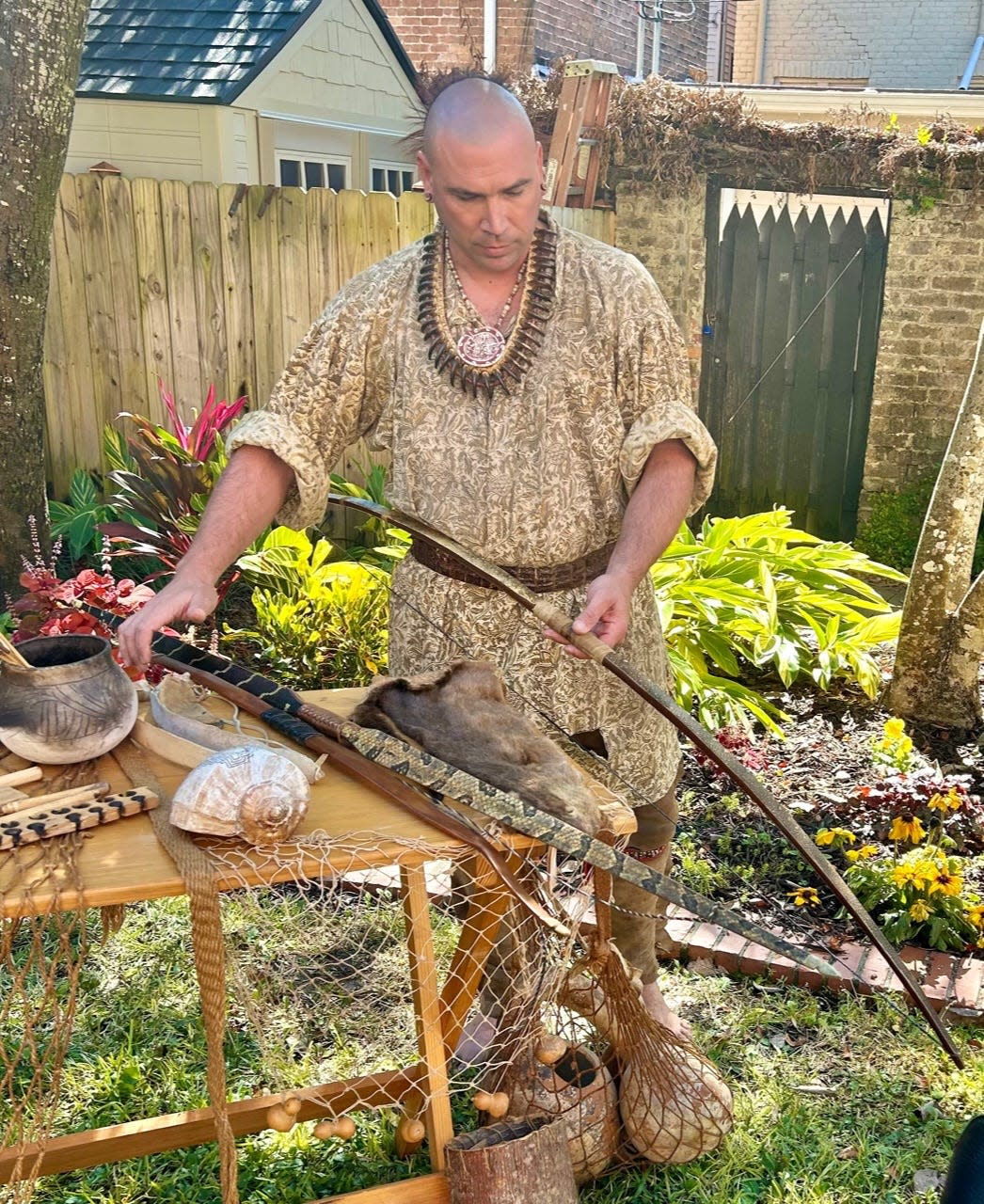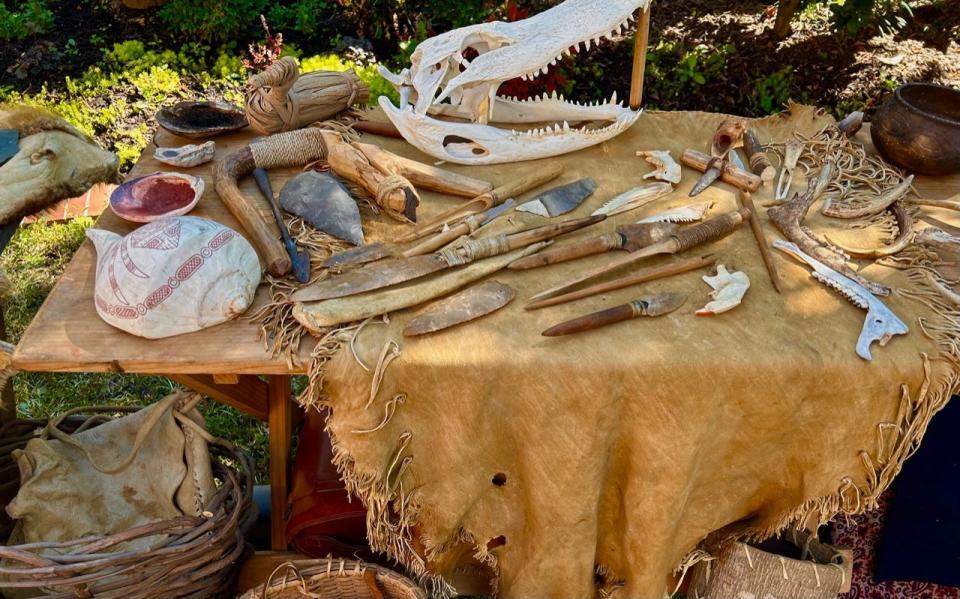For Native Americans, Thanksgiving is a day of mourning. This truth is also part of our story

- Oops!Something went wrong.Please try again later.
- Oops!Something went wrong.Please try again later.
With the recent release of “Killers of The Flower Moon” by Martin Scorsese, audiences are being exposed to more complicated narratives about the influence of white supremacy throughout U.S. history, especially when it comes to the treatment of Native Americans and other indigenous peoples. One can’t help but think that Scorsese chose to release the film when he did not only for Oscar consideration, but because it was near Thanksgiving, a holiday so closely aligned with the stories our nation has told itself and which has undergone its own level of scrutiny over the last decade.
English colonists famously landed at Plymouth Rock in the winter of 1620. The following year, around the time of the harvest, the story goes that the colonists and members of the Wampanoag tribe sat down for a meal. The mythology that has grown around that story has long ignored the subsequent destruction and oppression of Native American cultures. What has become a day of celebration for many is a National Day of Mourning and Protest to Indigenous people.
For a more nuanced understanding of the relationship that existed between indigenous tribes and the European colonists of the first Thanksgiving lore, consider reading "This Land Is Their Land: The Wampanoag Indians, Plymouth Colony, and the Troubled History of Thanksgiving" (Bloomsbury 2019) by David J. Silverman. The book’s tag line is, “Ahead of the 400th anniversary of the first Thanksgiving, a new look at the Plymouth colony's founding events, told for the first time with Wampanoag people at the heart of the story.”
Although that first Thanksgiving in what is now modern-day Massachusetts occurred more than a hundred years before General James Oglethorpe and his colonists arrived on the Georgia Coast in 1733, it does shed some light on how we characterize our own city's founding. What would a meal between the colonists and the Yamacraw or other tribes of Creek Indians have looked like? What would the indigenous people been hunting or gathering at this time of year? Would they consider the arrival of Oglethorpe and his crew worth celebrating or mourning?

Native Coastal Georgia heritage
At the recent Massie Heritage Center Native American Heritage Month celebration, Vinson Minor, a living-history demonstrator, discussed what Yamacraw and other Creek Indians might have been up to as far as food cultivation was concerned.
He mentioned that there would not have been any hunting laws or regulations. “It was fair game, but we all know that oysters are more valid in cooler months.”
In addition to oysters and fish, indigenous people would likely have eaten raccoon and turtles. As far as how he knows, he referred to today’s Eastern Wharf site and said, “That was nothing but oyster shell, broken pieces of pottery. You would find little raccoon and turtle bones and pieces of turtle shells.” All remnants of what the local tribes scoured for and then discarded. Indigenous locals also would have hunted deer, otter and beaver, as well. Not only would they eat the meat, they would use the skins for clothing, blankets and other needs.
He said the tribal people that took up farming would have grown the “three sisters of corn, beans and squash.” He shared an interesting fact that gourds were hollowed out and used to store drinking water. If water sat for too long, though, it could turn bitter. Minor said people would pour pine pitch in there and sometimes beeswax but “that would not have been available pre-contact [with Europeans].”
Since he was 18 years old, Minor has been doing “experimental archaeology” to learn and demonstrate traditional indigenous skills practiced by Native Americans of the Lowcountry. His own heritage is Cherokee, but he also has worked closely with Creek and Seminole people to accrue skills. Much of the knowledge he passed on involved creating tools and weapons such as spears and arrows for hunting or self-defense. Each would have hand made.
Massie Heritage Center has a few recordings of Vinson’s tools and weapons demonstrations available on its YouTube channel.
The Yamacraw and the Creek: New book puts Native Americans front and center in Savannah history
Native American Heritage resources
For more local context about indigenous people, readers can look to “Native American History of Savannah” (Arcadia Publishing, 2018) by Michael Freeman.
Anyone looking to broaden their knowledge of Native American cultures can start with Savannah’s local libraries. If people are seeking literature for, by or about Native Americans they can review materials via Georgia’s PINES library system, to which local Live Oak Public Libraries belong.
A Live Oak Library representative shared its Native American Heritage Month: Adult Reading List for 2023. Locally available options are listed below:
“Firekeeper's Daughter” by Angeline Boulley.
“There There” by Tommy Orange
“Trickster: Native American Tales: A Graphic Collection” edited by Matt Dembicki
“The Woman Who Married a Bear” by John Straley
“LaRose” by Louise Erdrich
“Killers of the Flower Moon: The Osage Murders and the Birth of the FBI” by David Grann
“Crazy Brave: a Memoir” by Joy Harjo
“Crossings: A Doctor-Soldier's Story” by Jon Kerstetter.
“A Thousand Moons: A Novel” by Sebastian Barry.
“The Earth is Weeping: The Epic Story of the Indian Wars for the American West” by Peter Cozzens
Live Oak also shared a previously curated Native American Heritage Month: Children's Reading List from 2021. “At the Mountain's Base” by Traci Sorell and illustrated by Weshoyot Alvitre, and “A Man Called Raven” by Richard Van Camp and illustrated by George Littlechild are both available locally.
Any books on the lists above that are not available in Live Oak libraries can be requested through the Georgia PINES library share. Library cards are free to all Georgia residents. People can register for a one online or in-person. A library card will allow residents to, “check out books, access digital resources online, get passes to museums and more.”
Joseph Schwartzburt is the education and workforce development reporter for the Savannah Morning News. You can reach him at JSchwartzburt@gannett.com.
This article originally appeared on Savannah Morning News: Reconciling the truth of Thanksgiving with the impact on Native Americans

